Lines are an essential element of both ballet and photography. “Ballet line” is the physical shape of the dancer’s body. Good ballet lines make the dancer appear effortless, fluid, and beautiful. It involves the whole body creating a position, “image,” or “good” line. The two main components of this shape are curves and angles. Correct technique and alignment of the limbs and the whole body in space directly affect the lines, including head and eye focus. Ballet dancers are more than athletes; they are also artists. The graceful line made by their legs and arms is imperative to perform the art of ballet. The limbs’ placement, extension, and shape make us stop and pay attention.
“Ballet is created on beautiful lines and shapes. If what you hear and what you see the mesh, there’s a very thrilling experience.” Martin Fridmann
Lines in photography composition or ballet can be actual lines or implied lines. Using strong dynamic lines in image composition or ballet positions adds impact. It is an element of design. Applying an extra level of thought before creating an image produce better images.
As a photographer, I describe lines as positive space (the dancer) against negative space (the empty background. Each defines the other. Both the foreground and the background define each other. A photograph is static—a split second in time. However, a photograph of a good arabesque should convey energy. The best lines have energy running through the entire pose from fingers to toes. The line of both the limbs, fingers, and foot leads an observer’s eye, curving outward and upward towards infinity. At the same time, the dancer’s eyes should also be looking at that infinity to finish the line.
Definition
Dancers continuously create lines and shapes through the movement of their bodies. To define “line” in ballet is to describe an aesthetic of the entire body, creating a pleasing “image.” The ballet line is the outline of the legs and arms the ballet dancer presents while performing. However, the ballet line is more than the body’s shape—it is the body’s overall harmonious outline. Limbs and torso work together from head to toe to create a seamless, sculptural quality. The line also includes the head and eye focus as well as the energy flow. These curves and angles formed by the dancer in space add up to a beautiful classical ballet line.
Silas Farley, a member of the New York City Ballet corps de ballet, explained the specific meaning line has in dance. “That’s our form of speech,” he said. “Your line is your voice, and your personality. Every dancer has a little different inflection in their line, like a different inflection in a speaking voice, or an accent. You see that in a body. We’re all trying to conform ourselves to these idea shapes.”
Achieving the ideal ballet lines
Muscle formation influences ballet line, the natural shape and length of a particular body, and the flexibility of ankles, elbows, and wrists. Achieving the ideal lines is done through repetitive practice. The structure and exercises in ballet classes are intended to create a long leg line, constantly elongating and stretching the muscles. Small corrections can make a big difference in the line that is created.
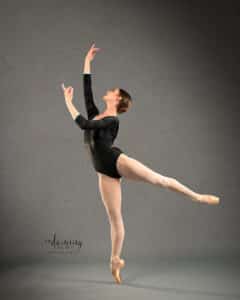 Macyn Vogt started ballet training at age twelve. She has danced with Joffrey Ballet in Chicago, the San Francisco Ballet School, the Charlotte Ballet II, and the Sarasota Ballet. Currently, she performs with the Indianapolis Ballet Company. She explained this photo “demonstrates good lines because of the fully straightened and slightly hyperextended legs and pointed feet. The back leg is at a proper 45° for a small arabesque that extends the line. The arms reaching up and following gaze creates the illusion of a longer line.”
Macyn Vogt started ballet training at age twelve. She has danced with Joffrey Ballet in Chicago, the San Francisco Ballet School, the Charlotte Ballet II, and the Sarasota Ballet. Currently, she performs with the Indianapolis Ballet Company. She explained this photo “demonstrates good lines because of the fully straightened and slightly hyperextended legs and pointed feet. The back leg is at a proper 45° for a small arabesque that extends the line. The arms reaching up and following gaze creates the illusion of a longer line.”
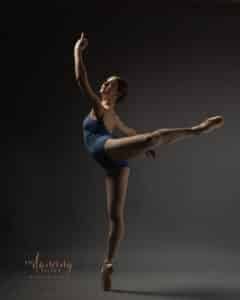 Attitude is a pose in which the dancer stands on one leg with the leg lifted in the back or front. The arm on the side of the raised leg is curved over the head. The other arm is held to the side. Macyn’s attitude pose creates a curving line running from the top of the left hand, down through the spine, and up through the lifted leg. This smooth curve is artistically pleasing. The attitude is executed with the supporting leg en pointe.
Attitude is a pose in which the dancer stands on one leg with the leg lifted in the back or front. The arm on the side of the raised leg is curved over the head. The other arm is held to the side. Macyn’s attitude pose creates a curving line running from the top of the left hand, down through the spine, and up through the lifted leg. This smooth curve is artistically pleasing. The attitude is executed with the supporting leg en pointe.
This is one of the most beautiful poses performed by a ballet dancer. And the attitude is one of the hardest to perfect.
If the head is too low or the leg too high, the spine is misaligned; it destroys the harmonious outline. Our brains see this as misshapen.
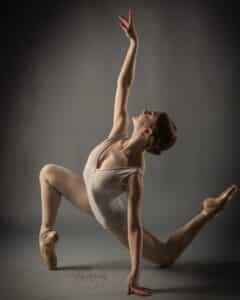
Macyn’s arms create a strong vertical line suggesting height and power. The energy flow is going in a straight line. This line is accentuated by her pointed index finger and her upward gaze. The diagonal lines add contrast and imply dynamism, action, and mobility. Achieving a “good line” is essential to the success of a professional dancer.
Use of lines in photography
Lines in a photograph can imply rest, movement, strength, grace, and beauty. They create visual interest.
Vertical lines portray a sense of height, power, growth, and strength. They also direct the viewer’s eyes upward.
Horizontal lines suggest peacefulness, rest, relaxation, and sleep. Horizontal lines are static.
Diagonal lines imply movement, dynamism, flow, action, and mobility. and acceleration
Curved lines are graceful and elegant. They lead the eyes of the viewer through the image. They flow within the image.
Converging lines draw the eye to a point or common intersection.
Converging lines can draw the viewer toward the middle of the intersection, but they can also do the opposite by becoming diverging lines. Diverging lines may fan the viewer out from the center, creating a balanced image.
In Summary
Lines are an essential element of both ballet and photography. A stunning composition uses lines to direct the viewer’s eyes in a way our brain perceives as pleasing. So, when a dancer or a photo creates a leading line or pattern of symmetry, it creates a beautiful image.
If you found this post helpful and informative, please share it on your social media.

Macyn Vogt
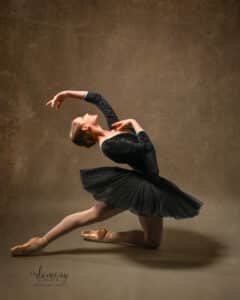
Macyn Vogt
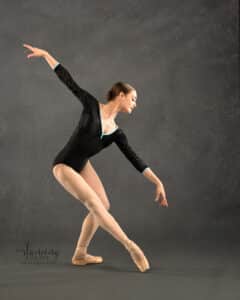
Macyn Vogt
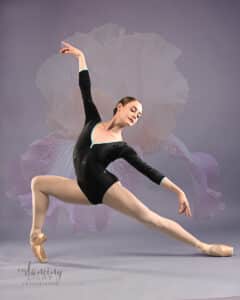
Macyn Vogt

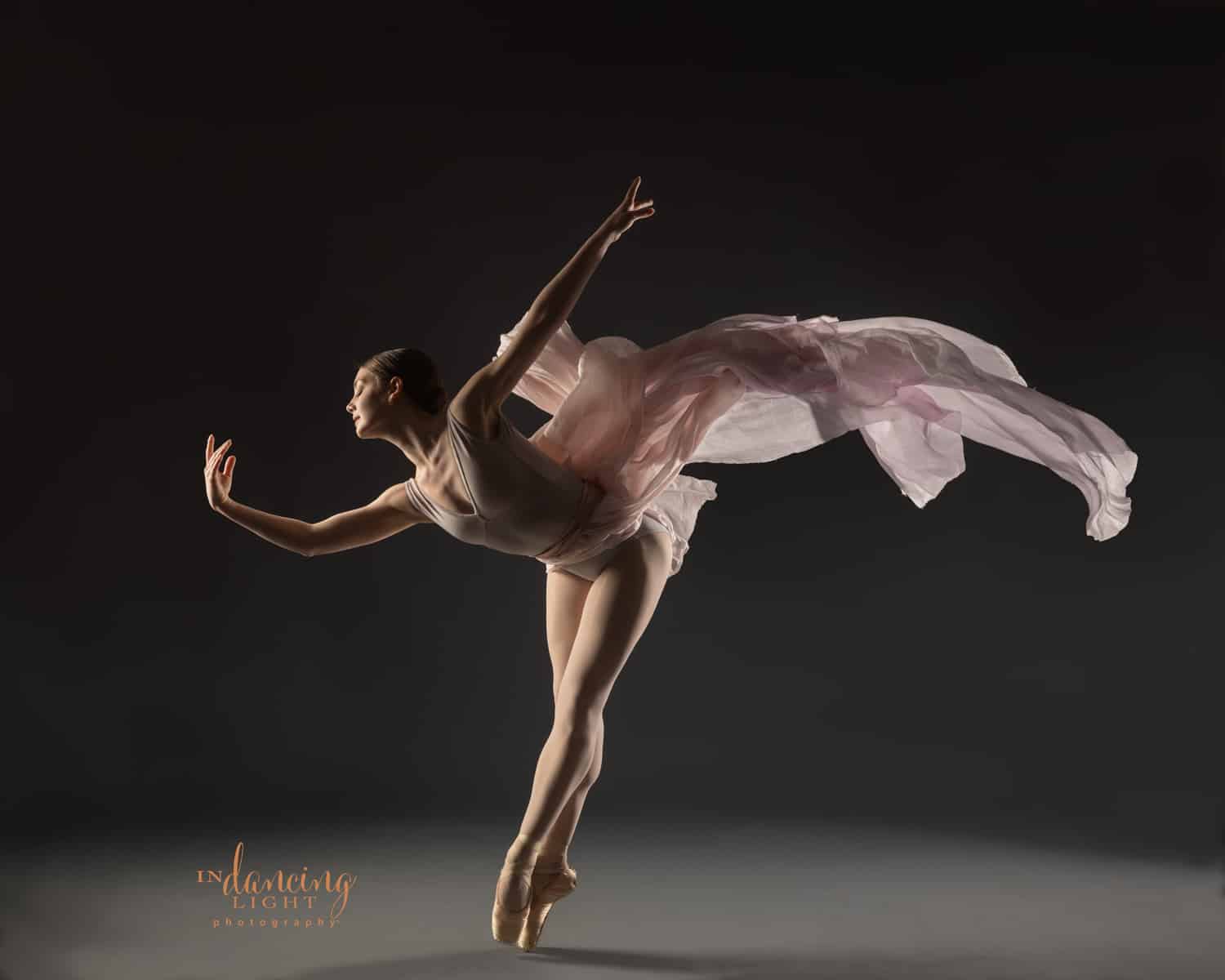
0 Comments